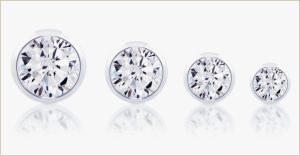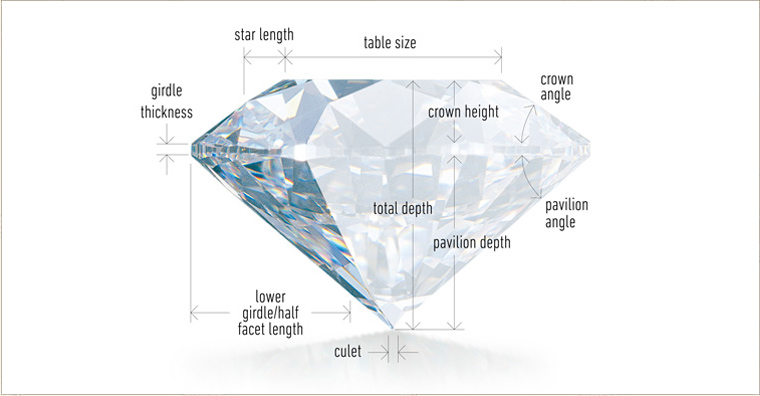Diamond Guide


The 4Cs
The 4Cs of diamond quality is a language jewelers everywhere use to describe the attributes of a diamond, that when taken together, help to determine its overall quality. Quality is ultimately tied to price, so it’s crucial that you learn the 4Cs so that you understand what you’re buying:

Carats
SIZE & WEIGHT
Diamond Carat Weight Measures a Diamond’s Apparent Size. Diamond carat weight is the measurement of how much a diamond weighs. A metric “carat” is defined as 200 milligrams. All else being equal, diamond price increases with diamond carat weight because larger diamonds are more rare and more desirable.
Each carat can be subdivided into 100 ‘points.’ This allows very precise measurements to the hundredth decimal place. A jeweler may describe the weight of a diamond below one carat by its ‘points’ alone. For instance, the jeweler may refer to a diamond that weighs 0.25 carats as a ‘twenty-five pointer.’ Diamond weights greater than one carat are expressed in carats and decimals. A 1.08 carat stone would be described as ‘one point oh eight carats.’
Clarity
Diamonds are created by nature under tremendous heat and pressure. Nearly all diamonds contain unique internal characteristics called inclusions and external characteristics called blemishes. Many clarity characteristics are too tiny to be seen by anyone other than a trained gemologist using magnification. The GIA Clarity Scale contains 11 grades ranging from Flawless to Included.
Color
Truly colorless diamonds are very rare and highly valued. The GIA Color Scale uses letters to represent the absence of color, beginning with D (colorless) and ending at Z (light yellow or brown). Color distinctions can be quite subtle and only visible to the trained eye, but the differences can have a significant impact on price.
Cut
While diamonds can be fashioned into different shapes, the term “cut” refers to how a diamond’s complex proportions and angles relate to light. A number of factors influence a diamond’s cut grade, including its overall face-up appearance, design and craftsmanship. The GIA Cut Scale for standard round brilliant cut diamonds ranges from Excellent to Fair.
DIAMOND SHAPES AND HOW THEY AFFECT VALUE
Guide to Diamond Shapes
Jewelry is one of the most popular gifts we use to mark the momentous occasions in our lives. It is an outward expression of what we mean to one another. Holidays, birthdays and anniversaries and other achievements are just some of the events we celebrate with special gifts of jewelry, and diamonds are among the most favorite to give.
The shape is an important consideration when buying a diamond as it directly influences price. Round diamonds, the most popular diamond shape, tend to be priced higher than other shapes (referred to as fancy shapes) because of market demand, increased manufacturing costs, and their incredible brilliance.
Fancy shaped diamonds include all diamonds other than round. We offer nine different fancy shapes, including princess, emerald, Asscher, cushion, marquise, radiant, oval, pear, and heart.
Choosing a fancy shaped diamond can save you more than 20% versus a round diamond of similar size and quality. Fancy shapes such as marquise, oval, and pear are elongated and tend to appear larger than a round. Nearly one-third of all engagement rings today are created with a fancy shaped diamond, the most popular shapes being princess, cushion, and radiant.
ROUND BRILLIANT CUT
The round brilliant cut diamond is the most popular shape of diamond. For hundreds of years, diamond cutters have been working with this cut to maximize its brilliance and fire. While this cut offers great flexibility within the four C’s, you will want to select higher quality grades to bring out the most brilliance within a round diamond.
RADIANT CUT
Perfect for those looking for a unique style, radiant cut diamonds feature uniquely trimmed corners which combines the lines of an emerald cut with the brilliance of a round diamond. The sparkle of this diamond cut looks beautiful when combined with a variety of other diamond cuts.
PRINCESS CUT
Princess cut diamonds are exceptionally brilliant because of the way they are cut and are available in both square and rectangular shapes. The color that is emitted from princess cut diamonds is very unique. While the color of other diamond is displayed mainly in the center, the princess cut diamonds show distinct color in each of the corners as well.
PEAR SHAPED
Combining round and marquise cuts, the teardrop style of pear shaped diamonds is exceptional. The slender pear shape will give fingers and hands a slimmer appearance while creating a soft and delicate look. Pear shaped diamonds are cut to produce maximum brilliance, so it’s important to look for excellent symmetry.
OVAL CUT
Oval cut diamonds have a classic appearance with a modern twist! It is a popular cut in all types of jewelry, especially in engagement rings, making it easy to match with other jewelry. It has an incredible brilliance, similar to the round brilliant cut, but also has the advantage of accentuating long, slender finders.
MARQUISE CUT
A marquise cut diamond is a perfect shape for maximizing carat weight by emphasizing the size of the diamond. Its unique shape creates the effect of longer, more slender hands and fingers. The outline of a diamond is determined by its length to width ratio, which also provides an image of the shape and look of the diamond.
EMERALD CUT
Emerald cut diamonds have a unique optical appearance because of the rectangular facets step-cut into the diamond’s pavilion. This cut showcases the diamond’s original clarity beautifully because of its large rectangular table which will also make inclusions and color more apparent.
CUSHION CUT
Sometimes called a pillow-cut diamond, the cushion cut is a timeless cut that has earned its name for its pillow shape. Cushion cut diamonds tend to have impeccable brilliance and clarity in their appearance which can be attributed to their rounded corners and larger facets. These diamonds are available in square and rectangular shapes.
ASSCHER CUT
Asscher cut diamonds are often mistaken for an emerald cut because of its similar cut style; however an asscher is square rather than rectangular. Created in the early 1920s, the asscher cut has recently resurged in popularity, especially amongst celebrities.



